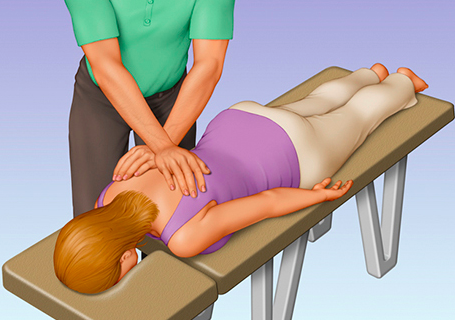Visit and Join the WeHeal Chiropractic Community
For more information, see: Mayo Clinic | Wikipedia

Chiropractic is a form of alternative medicine that focuses on diagnosis and treatment of mechanical disorders of the musculoskeletal system, especially the spine, under the belief that these disorders affect general health via the nervous system. It is the largest alternative medical profession, and although chiropractors have many similarities to primary care providers, they are more similar to a medical specialty like dentistry or podiatry. The main chiropractic treatment technique involves manual therapy, especially manipulation of the spine, other joints, and soft tissues, but may also include exercises and health and lifestyle counseling. The “specific focus of chiropractic practice” is chiropractic subluxation. Traditional chiropractic assumes that a vertebral subluxation or spinal joint dysfunction interferes with the body’s function and its innate intelligence. A large number of chiropractors want to separate themselves from the traditional vitalistic concept of innate intelligence.
Many studies of treatments used by chiropractors have been conducted, with conflicting results. Systematic reviews of this research have not found evidence that chiropractic manipulation is effective, with the possible exception of treatment for back pain. A critical evaluation found that collectively, spinal manipulation was ineffective at treating any condition. A Cochrane review found very low to moderate evidence that spinal manipulation therapy was any more effective than inert interventions, sham SMT or as an adjunct therapy for acute low back pain. Spinal manipulation may be cost-effective for sub-acute or chronic low back pain but the results for acute low back pain were insufficient. The efficacy and cost-effectiveness of maintenance chiropractic care are unknown.The evidence suggests that spinal manipulation therapy is safe, but the rate of adverse events is unknown as there is under-reporting. It is frequently associated with mild to moderate adverse effects, with serious or fatal complications in rare cases. There is controversy surrounding the level of risk of stroke from cervical manipulation. It has been suggested that the relationship is causative, but this is disputed by many chiropractors who believe it is unproven.
Chiropractic is well established in the United States, Canada, and Australia. It overlaps with other manual-therapy professions, including massage therapy, osteopathy, and physical therapy. Back and neck pain are the specialties of chiropractic but many chiropractors treat ailments other than musculoskeletal issues. Most who seek chiropractic care do so for low back pain.
D.D. Palmer founded chiropractic in the 1890s, and his son B.J. Palmer helped to expand it in the early 20th century. It has two main groups: “straights”, now the minority, emphasize vitalism, innate intelligence and spinal adjustments, and consider vertebral subluxations to be the cause of all disease; “mixers”, the majority, are more open to mainstream views and conventional medical techniques, such as exercise, massage, and ice therapy. Throughout its history, chiropractic has been controversial. Chiropractic’s foundation is at odds with mainstream medicine, and has been sustained by pseudoscientific ideas such as subluxation and innate intelligence that are not based on solid science. Despite the overwhelming evidence that vaccination is an effective public health intervention, among chiropractors there are significant disagreements over the subject, which has led to negative impacts on both public vaccination and mainstream acceptance of chiropractic. The American Medical Association called chiropractic an “unscientific cult” in 1966 and boycotted it until losing an antitrust case in 1987. Chiropractic has had a strong political base and sustained demand for services; in recent decades, it has gained more legitimacy and greater acceptance among medical physicians and health plans in the U.S., and evidence-based medicine has been used to review research studies and generate practice guidelines.
Visit and Join the WeHeal Chiropractic Community
For more information, see: Mayo Clinic | Wikipedia
WeHeal is very grateful to our valued sources of information which include Wikipedia, WebMD, ClinicalTrials.gov, Cancer.gov, Infoplease, and the US CDC (Center for Disease Control).